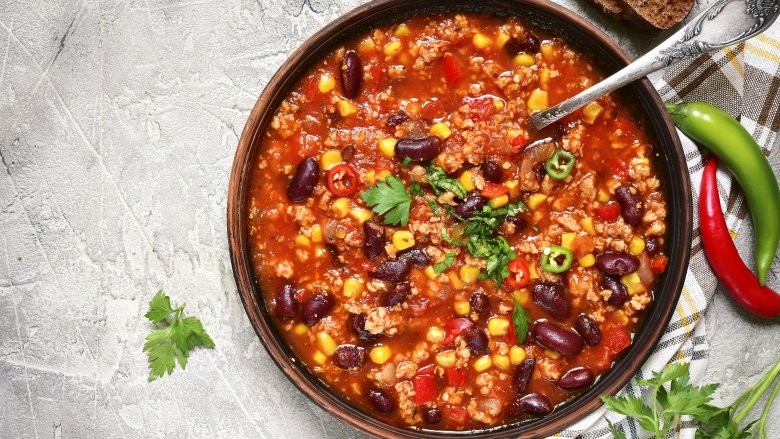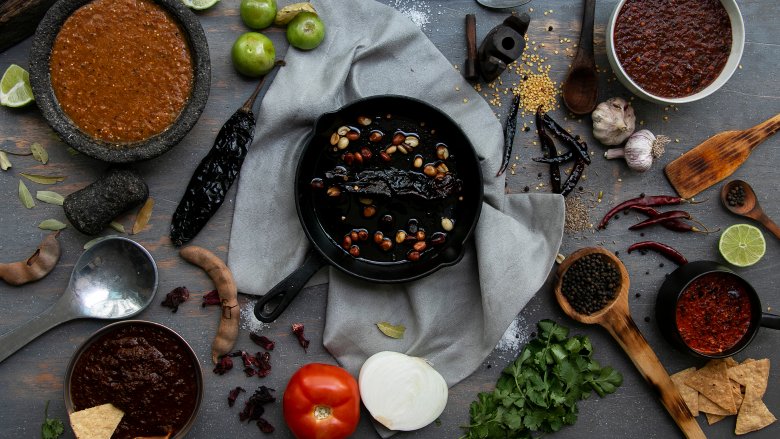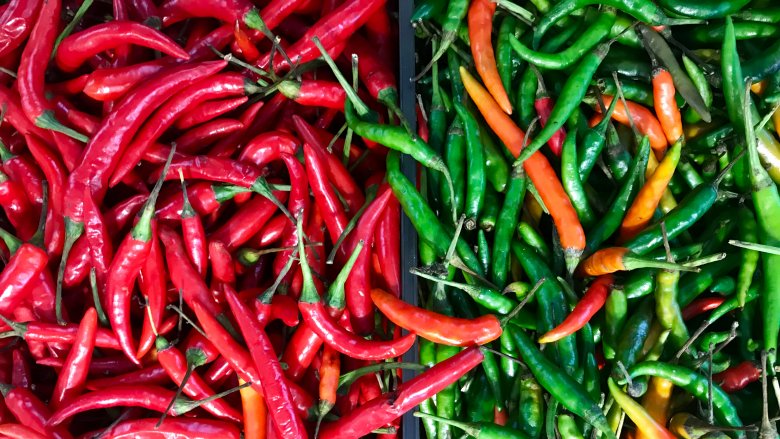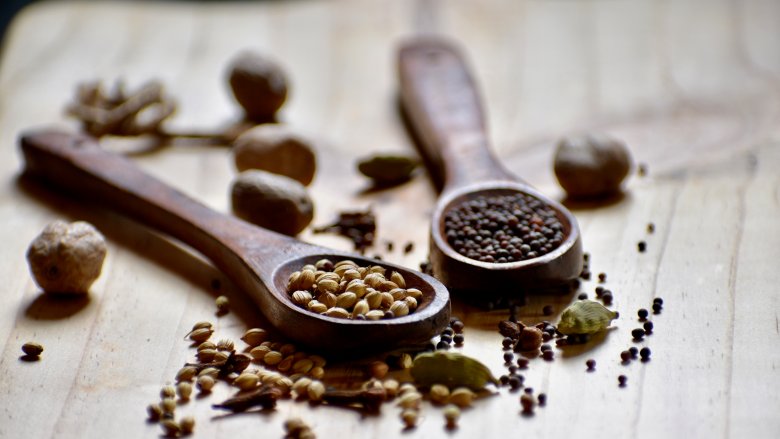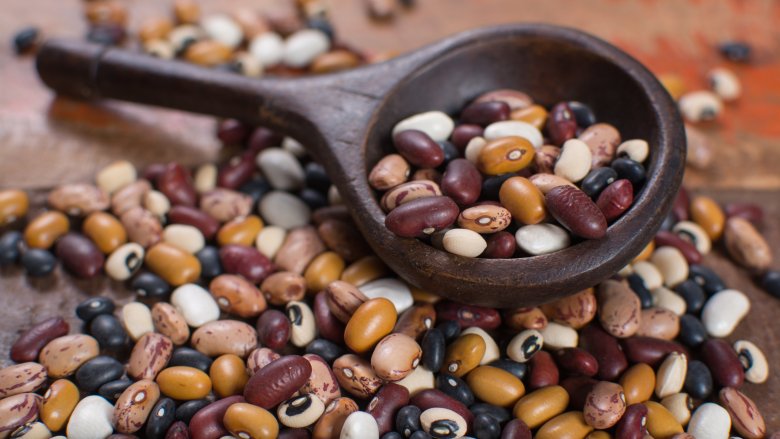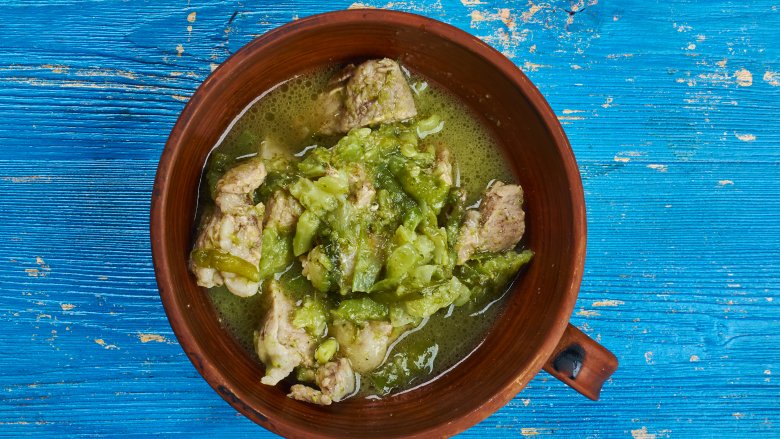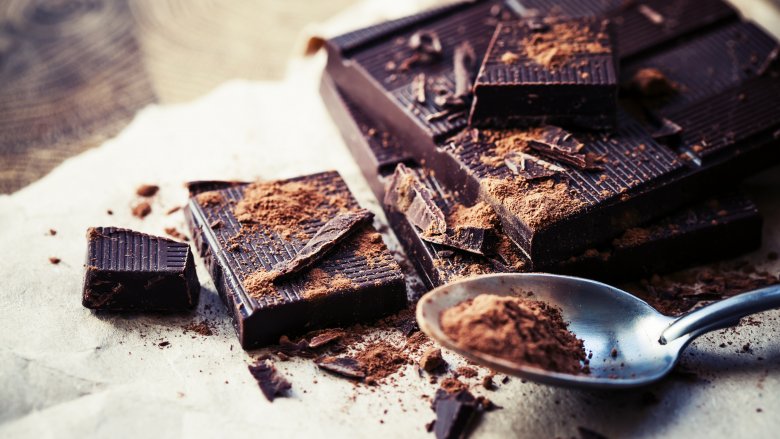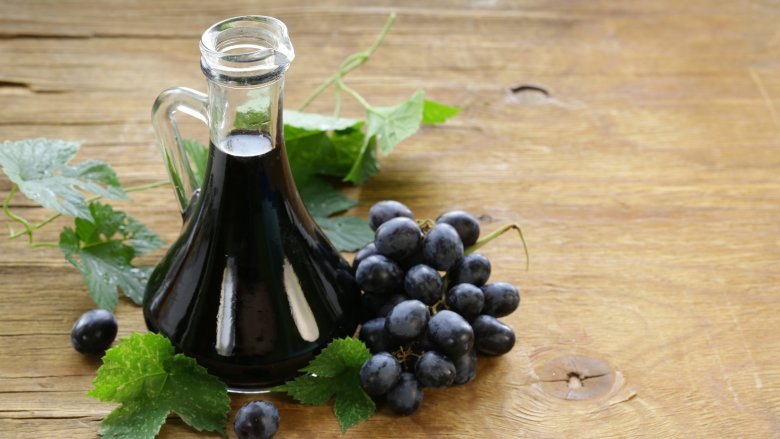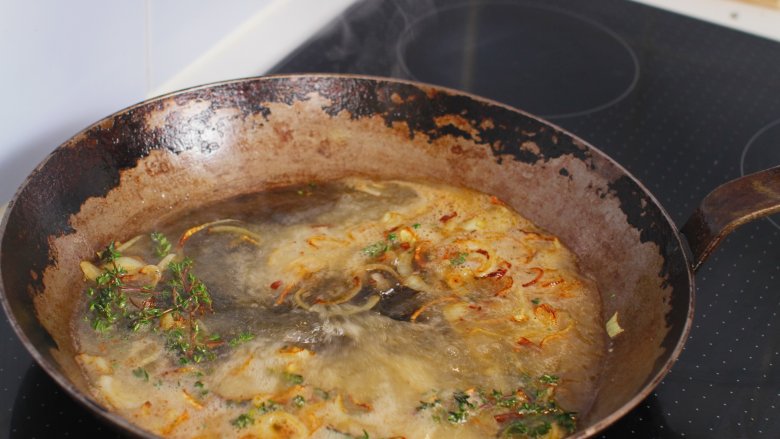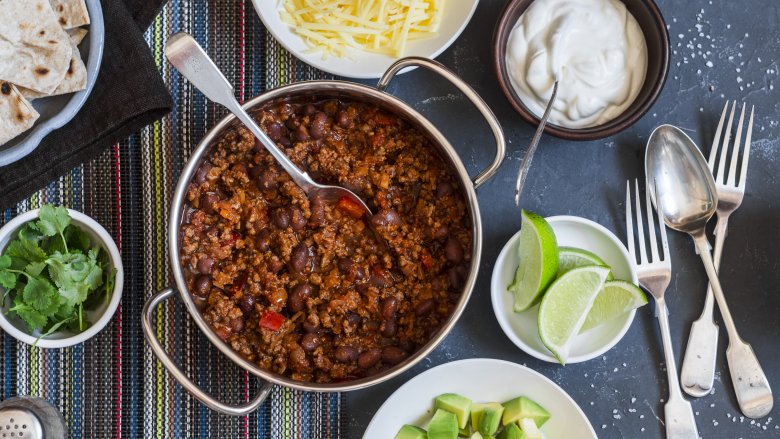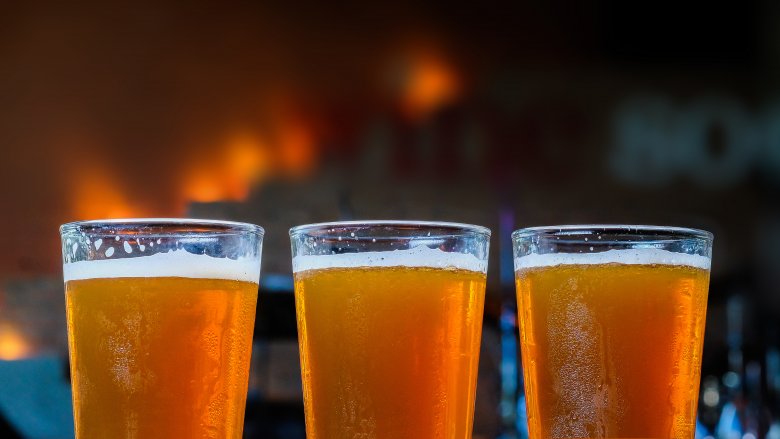You'll Wish You'd Made Chili Like This Sooner
The perfect chili can be a difficult thing to muster. There are so many ways you can go wrong: it can be too tomatoey, too acidic, too hot, too mild, too overloaded with vegetables, too bland, too rich, and a whole lot more things you don't want it to be. Considering how easy they are to make, it's surprising how often they can go wrong.
Even if you're a chili maestro, however, there are a few things you ought to be taking into account when you're rustling up your next batch. Sure, you may have mastered your ratios, nailed your ingredients, and come up with the perfect little quirks that make your chili unique, but if you're not doing these things, then you're just not getting it right. From mixing your own seasonings, to toasting your spices, to getting down with the art of deglazing — give them a go, and it's a safe bet that you'll never look back.
Put down that spice mix
This is rule numero uno when it comes to making chili. It's far, far too tempting to rely on store-bought premade seasoning mixes as the source for pretty much all of your flavor — and this includes the jars of chili powder you pour into your dish by the handful. Spices are arguably the most important part of the chili — and remember, people fought literal wars to get hold of this stuff — so why would you ever be happy half-assing them?
So put down the packets and jars of mixed spices and get yourself a rack of fresh spices instead. The best thing about making your own mix is that you get free reign when it comes to customization, meaning you can experiment to your heart's content until you land on the perfect mix for your chili. Generally, you're going to want to be using stuff like cumin, garlic, paprika, oregano and, of course, ground chiles. You're not restricted to anything, though. Throw in some coriander or ginger or saffron or even fennel seed, for all we care. The world is your oyster.
Try new chiles
Chiles are a pretty crucial part of your chili. The clue's in the name, see? Since some chiles are more commonly found and used in cooking than others, however, many people fail to really branch out and risk trying something different.
Chiles aren't only distinguishable for how hot they are, but also for which notes of flavor they give off. For example, Chipotle peppers have a sweet and smoky flavor, while Cascabels are rich, woodsy, and hot. Pasilla chiles are deeply flavored, with hints of berry, tobacco, and licorice, and Pasilla de Oaxaca will add a dash of fruitiness to your chili. Nowadays, there are thousands upon thousands of chile varieties out there in the world; that's a hell of a lot of different ways to spice up your recipe. Order yourself a load of them and start mixing and matching with your spices. Eventually, you'll find the perfect combination — and once you do, everything else will fall neatly into place.
Use whole spices (and toast them!)
Once you've locked down that spice mix, you're obviously going to want to add them to chili. Hold your horses, though, because there's one more hoop left to jump through. See, all those containers full of powdered spices on your rack are holding you back. In fact, whole spices are where you want to be.
The advantages of using whole spices are numerous. For one, they last longer than powders. They also look pretty dynamite, and using them is a decent way of tricking your friends and family into thinking you actually know anything about cooking. Most of all, however, they can be toasted on your stove. According to Serious Eats, toasting your spices heats the flavor compounds within them, making them recombine to form more complex aromas. This helps to draw out flavor and make your chili far more intense. Once they're toasted and dried in the skillet, they can be ground down into powder and added to your recipe. It's as simple as that — but the results can be stunning.
Dried beans beat canned beans
Next step: the beans. As you might expect, the quicker and easier option here isn't necessarily the best one. Canned beans can save you a headache in the kitchen, but, according to Bon Appetit, there's a decent argument to be made for using dried beans instead.
To begin with, they're highly cost-effective and come in plenty of varieties to try out and experiment with. The only problem is the time they take to prepare: dried beans need to be soaked in water for several hours or overnight. You're also going to need to add a few hours to allow the beans to simmer with the spices you're using to flavor them before they can be used in your chili. What you'll get, however, are beans infused with an incredible amount of flavor that'll kick your chili into the stratosphere. Given the choice between taste and simplicity — well, it's no choice at all, is it?
Try new meats
The assumption we often make with chili is that it ought to be made with ground beef. It's a fair assumption to make, considering it does taste really good, but here, as with everywhere else in your chili, it's always possible to experiment.
Chili can be made with a whole range of meats, and (obviously) swapping in different things is going to completely transform the taste of your batch. Different meats you could use include chicken, pork, chorizo, turkey, and Italian sausage. Of course, you could always cut out meat entirely, and opt either for a meat substitute or for a simple bean-only chili. All the different spices, chiles, beans, and ingredients you're using are likely to work with each meat in their own ways. Changing the meat in your chili constitutes a radical, from-the-ground-up reworking of your dish, and should prove to be a good starting point if you want to try something completely new.
Extra touches
So your beans are bursting with flavor, your spices are sizzling and your meats are all cooked up. What next? Well, it's up to you. In fact, once you've got that chili going for real, there are a whole host of different ingredients you can add to give it an extra burst of flavor — many of which you might never have thought of using.
Brewed coffee can complement your chili's earthy tones, chocolate will benefit the mouthfeel and add more complexity to the flavor, and even cola can give the chili an utterly unique kind of sweetness that no other ingredient can. Oh, and you could also give soy sauce, whiskey, honey, coconut milk, cranberries, cauliflower, mango, olives, or beer a good go, too. Each addition will do something different for your chili. Remember: fortune favors the bold, here, and nothing is too weird. Just be restrained with your experimentation, yeah? Nobody likes a chili which uses coffee, chocolate, cola, soy sauce, whiskey, honey, coconut milk, cranberries, cauliflower, mango, olives and beer, all at once.
Get balsamic
Once your chili is almost done, there's one more crucial ingredient you can add that'll make it pretty much perfect: balsamic vinegar. Most chili is tomato-based, and balsamic vinegar is basically legendary for how well it works with tomatoes, so matching them up together in your own chili seems like an obvious way to bring it to perfection. Although it's up to you just when you should add the vinegar to the chili, and it's entirely possible to throw it in earlier on, doing it towards the end of the process is more likely to bring its zest and acidity to the fore.
What you'll get is a slightly sweet kick to your chili that should go nicely hand-in-hand with the zest and heat of your actual chiles and spices. You won't need much — a splash will do — but, in this case, a little effort will go a long, long way.
Deglaze, deglaze, deglaze
Getting into a habit of deglazing your pan during the cooking process will change your chilis forever. It's a really simple process: basically, you pour cold liquid into a hot pan to bring up all the residue stuck to the bottom, which is known as the fond. Almost any liquid can be used to deglaze your pan, including alcohol. For your chili, you'd do well to try things like beer, vinegar, wine, or stock.
What you'll end up with is a double whammy of flavor. Releasing the frond after browning your meat and frying your vegetables will make your chili just that much richer and tastier, and the addition of the liquid (chosen properly) can't hurt either. Deglazing your pan while making chili will add a grand total of five or six minutes to the length of the cooking process, but you'll notice the results almost immediately in the finished batch.
All hail the chili bar
Remember: the game doesn't end when you've made the chili. In fact, getting the toppings to your chili just right can be as important as the cooking itself. Because everyone's tastes are different, if you're serving chili for a crowd your best bet might be to make a chili bar.
Luckily, they're easy to do. Once your chili is prepared, you bring together a load of toppings and side dishes (as well as drinks, but we'll come to that). Sides-wise, Whole and Heavenly Oven recommends homemade cornbread, chips 'n' dip, rolls, and softened butter. As for toppings, you can't go wrong with shredded cheese, sliced avocado, sour cream, shredded lettuce, sliced olives, chopped tomatoes, guacamole, crushed tortilla chips, and salsa — but this is also another chance to get weird with it, too. Experiment!
Lay everything out in bowls, get that chili just perfect ,and give yourself a reward for a job well done. Speaking of which...
Get boozy
Nothing goes better with chili than a little bit of booze, and it's vital that you find a drink that pairs perfectly with your dish. Luckily, you've got a lot of choice here.
According to The Spruce Eats, the best beers for chili are flexible and able to complement the heat, meat and spices of the chili and your toppings. Vienna lager, which is popular in Mexico under the brands Negra Modelo and Dos Equis Amber, will do this perfectly. Simple cocktails will work too, and counteract the complexity of the chili itself, so look for Pimms, Presbyterians or Palomas. Red wine is probably best (especially if you're using beef), and in particular malbec, shiraz, tempranillo and certain cabernet sauvignons will pair nicely with a chili. White and sparkling wines should do fine as long as they're dry.
Getting your drink right will add a final, fantastic touch to what should — with a little diligence and trial-and-error — prove to be the perfect chili.
